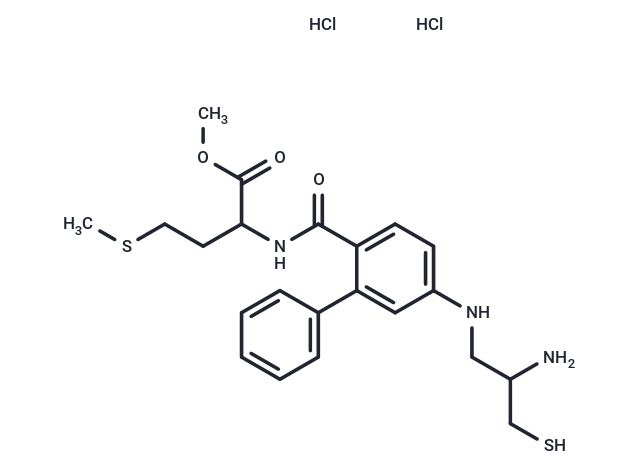Shopping Cart
Remove All Your shopping cart is currently empty
Your shopping cart is currently empty
FTI-277 hydrochloride (FTI 277 HCl) is an effective and specific farnesyltransferase (FTase) inhibitor (IC50: 500 pM); this selectivity is about 100-fold than the closely related GGTase I.

| Pack Size | Price | USA Warehouse | Global Warehouse | Quantity |
|---|---|---|---|---|
| 1 mg | $48 | In Stock | In Stock | |
| 2 mg | $67 | In Stock | In Stock | |
| 5 mg | $97 | In Stock | In Stock | |
| 10 mg | $169 | In Stock | In Stock | |
| 25 mg | $337 | In Stock | In Stock | |
| 50 mg | $553 | In Stock | In Stock | |
| 100 mg | $787 | In Stock | In Stock | |
| 200 mg | $1,070 | - | In Stock | |
| 1 mL x 10 mM (in DMSO) | $109 | In Stock | In Stock |
| Description | FTI-277 hydrochloride (FTI 277 HCl) is an effective and specific farnesyltransferase (FTase) inhibitor (IC50: 500 pM); this selectivity is about 100-fold than the closely related GGTase I. |
| Targets&IC50 | FTase:500 pM |
| In vitro | In mouse models infected with Hepatitis B Virus (HBV) and Hepatitis D Virus (HDV), FTI-277 administered intraperitoneally at a dosage of 50 mg/kg/day effectively clears Hepatitis D viremia. |
| In vivo | In drug-resistant myeloma cells, FTI-277 inhibits cell growth and induces apoptosis. It mitigates the toxicity induced by methamphetamine in SH-SY5Y cells through effects on cell degeneration, activation, the c-Jun N-terminal kinase cascade, and the Ras activation process. FTI-277 inhibits Ras processing (IC50: 100 nM) without affecting the overall cellular prenylation of Rap1A. Additionally, FTI-277 increases post-irradiation apoptosis and enhances the radiation sensitivity of H-ras transformed rat embryo cells. |
| Kinase Assay | FTase and GGTase I Activity Assay: FTase and GGTase I activities from 60,000×g supernatants of human Burkitt lymphoma (Daudi) cells are assayed. Inhibition studies are performed by determining the ability of Ras CAAX peptidomimetics to inhibit the transfer of [3H]farnesyl and [3H]geranylgeranyl from [3H]farnesylpyrophosphate and [3H]geranylgeranylpyrophosphate to H-Ras-CVLS and H-Ras-CVLL, respectively. |
| Cell Research | Cells are seeded at 8000–14 000 cells/well in 96-well plates. To establish a dose–response to FTI-277, cells are incubated for 96 h in two-fold serial dilutions ranging from 3.75 times 10-7 M to 1 times 10-5 M. Following continuous drug exposure, 50 μL MTT dye is added. The insoluble formazan complex is solubilized with DMSO and absorbance measured at 540 nm. IC50s and 95% confidence intervals are calculated by regression analysis of the linear portion of the dose–response curve. (Only for Reference) |
| Synonyms | FTI 277 HCl |
| Molecular Weight | 484.07 |
| Formula | C22H30ClN3O3S2 |
| Cas No. | 180977-34-8 |
| Smiles | Cl.Cl.COC(=O)C(CCSC)NC(=O)c1ccc(NCC(N)CS)cc1-c1ccccc1 |
| Relative Density. | no data available |
| Storage | Pure form: -20°C for 3 years | In solvent: -80°C for 1 year | Shipping with blue ice/Shipping at ambient temperature. | |||||||||||||||||||||||||
| Solubility Information | Ethanol: 12 mg/mL (24.79 mM), Sonication is recommended. H2O: 14 mg/mL (28.92 mM), Sonication is recommended. DMSO: 145 mg/mL (299.54 mM), Sonication is recommended. | |||||||||||||||||||||||||
| In Vivo Formulation | 10% DMSO+40% PEG300+5% Tween 80+45% Saline: 3.3 mg/mL (6.82 mM), Sonication is recommended. Please add the solvents sequentially, clarifying the solution as much as possible before adding the next one. Dissolve by heating and/or sonication if necessary. Working solution is recommended to be prepared and used immediately. The formulation provided above is for reference purposes only. In vivo formulations may vary and should be modified based on specific experimental conditions. | |||||||||||||||||||||||||
Solution Preparation Table | ||||||||||||||||||||||||||
Ethanol/H2O/DMSO
| ||||||||||||||||||||||||||
| Size | Quantity | Unit Price | Amount | Operation |
|---|

Copyright © 2015-2025 TargetMol Chemicals Inc. All Rights Reserved.